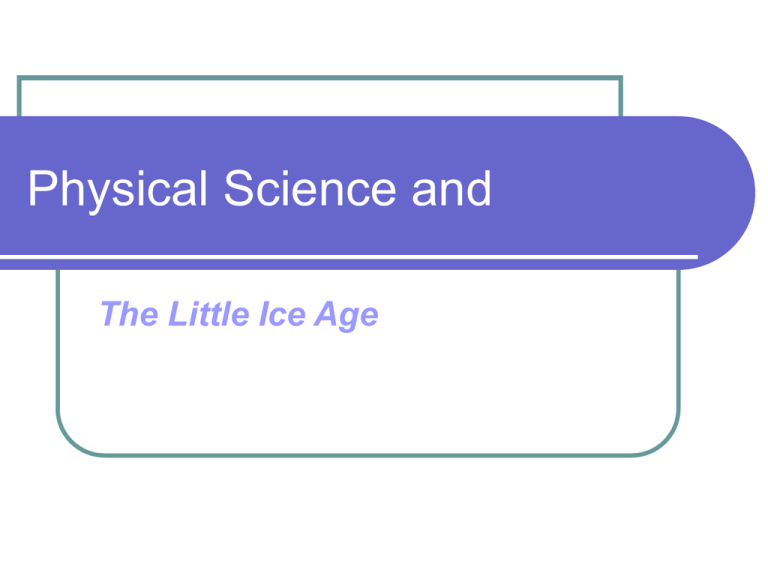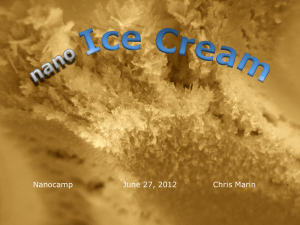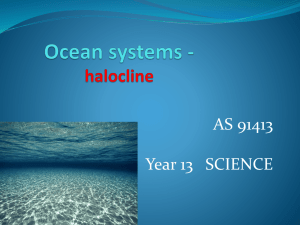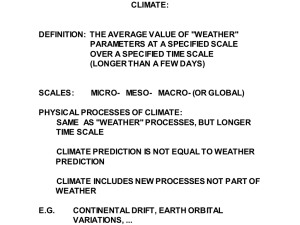The Little Ice Age
advertisement

Physical Science and The Little Ice Age The Little Ice Age The Little Ice Age was a period of dramatic cooling after a warm period like we are living in now. Scientists do not know exactly when the Little Ice Age began, but many believe that the coldest years were between 1550 and 1850. The Little Ice Age Continued… The Little Ice Age is characterized by very cold winters and cold, wet summers. The year 1816 was known by many as “the year without a summer.” Many summers during the Little Ice Age were spent around fires. Imagine if you had to turn the heat on in your house during the summer! Can you imagine a year without a summer? This is a graph showing the decrease in temperature during the Little Ice Age. Notice how low the temperatures were between the years 1500 and 1800! The Little Ice Age continued… The Little Ice Age is known to have affected Europe, North America, Africa, and many other parts of the world. Many believe it was even a global Ice Age. For example, there are reports of permanent snow on the peaks of mountains in Ethiopia, and in 1836 there were reports of snow in Sydney, Australia! There has not been snow in either places since these reports were made. Both Ethiopia, Africa and Sydney, Australia are below the equator and are known for their warm temperatures. Effects of the Little Ice Age The Little Ice Age had many effects on the people and places it touched. Effect on farming and food- The Little Ice Age shortened the growing season by at least one to two months per year. Because of this shortened growing season, farmers in Europe had to adapt to this shortened growing season. Because of this, there were many years of famine and death during the Little Ice Age. Remember the Vikings of Greenland and Iceland? Well these unbelievable people who almost certainly discovered North America were wiped out because of the Little Ice Age. The climates of Greenland and Iceland could not support enough food to ensure the survival of the Vikings. Effects of the Little Ice Age Effects on health- Imagine years and years of extremely cold and wet weather. Imagine how many people would become sick because of this weather. This is what happened as a result of the Little Ice Age. The poor nutrition of the people in Europe and other places in addition to the extremely cold temperatures caused the deaths of millions of people in Europe. Diseases such as the Black Death and St. Anthony’s Fire in addition to common illnesses such as the flu and colds caused the death rate to outnumber the birth rate in Europe during the mid to late 1500’s! Imagine living during this time without medicines, furnaces to keep you warm, or enough food to keep you strong and healthy. What would you do to survive? Effects of the Little Ice Age Other effects of the Little Ice Age- The Little Ice Age caused many ocean shores and rivers to freeze which normally never freeze. This freezing caused many warm water fish to move, which decreased the food supply. The increased cold caused glaciers to advance from the mountains in many areas. Eventually these glaciers moved onto the villages below the mountains, destroying them. The cold weather made the trees at the time denser. Many people believe that the woodwind instruments (like the violin) made during the Little Ice Age sound better because of the rare wood that was used to make them. Effects of the Little Ice Age The Little Ice Age affected North America as well. There are reports of ice on Lake Superior as late as June, which is very rare. In 1780, even New York harbor froze. People could actually walk from Manhattan to Staten Island while the harbor was frozen over. Of course, you all remember this picture of George Washington crossing a frozen Delaware River. The strange thing about this picture is that the Delaware River rarely freezes over! The Little Ice Age actually had an effect on the Revolutionary War! Physical Science- Causes of the Little Ice Age Scientist do not know the exact cause of the Little Ice Age. Many believe that the Little Ice Age was caused by a number of different factors. Scientists have studied ice cores, tree rings, the sun, and many other things to find the cause of the Little Ice Age. Ice Cores Ice cores have been used in the study of the Little Ice Age. Ice cores are cylinder shaped pieces of ice that are drilled out of ice caps and glaciers. Glaciers and ice caps are huge pieces of ice that are formed by the continual build up of ice over a long period of time. Ice cores up to two miles long have been drilled out of ice caps and glaciers! Ice Cores Notice the rings that the ice cores are made out of. The ice in between each ring is the amount of ice added to the glacier in that particular year. Ice cores can be used to show what the weather was like up to 900,000 years ago, if the ice core is long enough. Each layer contains thousands of tiny bubbles of air. Say there are air bubbles in a layer formed 100,000 years ago. Well, the air bubbles inside that layer contain the same air that was present 100,000 years ago! Ice Cores By studying the air inside of air bubbles, scientists can find out what the atmosphere was composed of at the time of the Little Ice Age. Ice cores have proven to be very useful in finding the cause of the Little Ice Age. It has been determined that the Little Ice Age was a time of increased volcanic activity. The dust and other gases released from the volcanoes have been trapped in the ice from that time period. The huge amount of dusts and gases released by these volcanic eruptions may have been what caused the Little Ice Age. The ash and gases that are released from a volcano produce a cloud that can cover the whole earth. The sulfuric gas that is released from a volcano can reflect the suns rays and the ash clouds can block the sun’s rays. Depending on the number of eruptions, volcanoes could have been the cause of the Little Ice Age. Tree Rings Tree rings can’t really explain the reason for the Little Ice Age, but they are some of the best evidence that proves that the Little Ice Age took place. If you cut down a tree, you can see distinct rings that go around the tree. Each of these rings represents one year. If the ring is large, that means that there was a lot of growth that year, and the climate was good for that tree to grow in. Tree rings from the years during the Little Ice Age are known to be small, which could mean that the climate was not suitable for these trees. The Sun Scientist know that there was a decrease in sunspot activity during the Little Ice Age. Observers who lived during the Little Ice Age even noticed the lack of sunspots. Although scientists have not been able to prove that a decrease in sunspots will decrease temperature, many still believe that the lack of sunspots is one of the causes of the Little Ice Age. Sunspots are regions on the surface of the sun that are cooler and darker than the surrounding areas of the sun. While less sunspots would seem to produce warmer temperatures, many scientists believe that less sunspots produce colder climates. The Little Ice Age Scientists are still trying to find the main cause of the Little Ice Age, but it seems to have been caused by a combination of the things we talked about earlier. Finding the cause of the Little Ice Age is so important because it could give us clues as to when the next ice age may come. Scientists consider the warming period that we live in today to be very rare! Because of this, it is possible that the next ice age may come within our lifetimes; we just don’t know when it will come. Bibliography Information: http://www2.sunysuffolk.edu/mandias/lia/little_ice_age.html http://www.grisda.org/origins/10051.htm, Tkachuck, Richard http://www.cdc.gov/ncidod/eid/vol6no1/reiter.htm Reiter, Paul http://en.wikipedia.org/wiki/Little_Ice_Age http://earthobservatory.nasa.gov/Study/Paleoclimatology_IceCores/ Riebeek, Holly http://www.talkorigins.org/faqs/icecores.html http://www.answers.com/topic/sunspot Images: http://en.wikipedia.org/wiki/Little_Ice_Age http://www.noaanews.noaa.gov/stories2005/s2372.htm web.utk.edu/~grissino/gallery.htm www.bananabaymarina.com/activities.htm http://news.bbc.co.uk/2/hi/science/nature/3792209.stm http://www.koshland-science-museum.org/exhibitgcc/historical10.jsp http://www.railwayana.net/rarity/jigsaws/jigsawguide.htm http://www.worldpress.org/images/maps/world_600w.jpg http://www.impawards.com/2002/posters/ice_age.jpg









